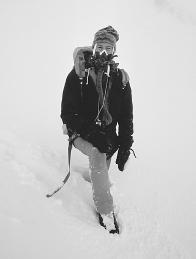Pressure - How it works
Force and Surface Area
When a force is applied perpendicular to a surface area, it exerts pressure on that surface equal to the ratio of F to A, where F is the force and A the surface area. Hence, the formula for pressure ( p ) is p = F / A. One interesting consequence of this ratio is the fact that pressure can increase or decrease without any change in force—in other words, if the surface becomes smaller, the pressure becomes larger, and vice versa.
If one cheerleader were holding another cheerleader on her shoulders, with the girl above standing on the shoulder blades of the girl below, the upper girl's feet would exert a certain pressure on the shoulders of the lower girl. This pressure would be equal to the upper girl's weight ( F, which in this case is her mass multiplied by the downward acceleration due to gravity) divided by the surface area of her feet. Suppose, then, that the upper girl executes a challenging acrobatic move, bringing her left foot up to rest against her right knee, so that her right foot alone exerts the full force of her weight. Now the surface area on which the force is exerted has been reduced to half its magnitude, and thus the pressure on the lower girl's shoulder is twice as great.
For the same reason—that is, that reduction of surface area increases net pressure—a well-delivered karate chop is much more effective than an open-handed slap. If one were to slap a board squarely with one's palm, the only likely result would be a severe stinging pain on the hand. But if instead one delivered a blow to the board, with the hand held perpendicular—provided, of course, one were an expert in karate—the board could be split in two. In the first instance, the area of force exertion is large and the net pressure to the board relatively small, whereas in the case of the karate chop, the surface area is much smaller—and hence, the pressure is much larger.
Sometimes, a greater surface area is preferable. Thus, snowshoes are much more effective for walking in snow than ordinary shoes or boots. Ordinary footwear is not much larger than the surface of one's foot, perfectly appropriate for walking on pavement or grass. But with deep snow, this relatively small surface area increases the pressure on the snow, and causes one's feet to sink. The snowshoe, because it has a surface area significantly larger than that of a regular shoe, reduces the ratio of force to surface area and therefore, lowers the net pressure.
The same principle applies with snow skis and water skis. Like a snowshoe, a ski makes it possible for the skier to stay on the surface of the snow, but unlike a snowshoe, a ski is long and thin, thus enabling the skier to glide more effectively down a snow-covered hill. As for skiing on water, people who are experienced at this sport can ski barefoot, but it is tricky. Most beginners require water skis, which once again reduce the net pressure exerted by the skier's weight on the surface of the water.
Measuring Pressure
Pressure is measured by a number of units in the English and metric—or, as it is called in the scientific community, SI—systems. Because p = F / A , all units of pressure represent some ratio of force to surface area. The principle SI unit is called a pascal (Pa), or 1 N/m 2 . A newton (N), the SI unit of force, is equal to the force required to accelerate 1 kilogram of mass at a rate of 1 meter per second squared. Thus, a Pascal is equal to the pressure of 1 newton over a surface area of 1 square meter.
In the English or British system, pressure is measured in terms of pounds per square inch, abbreviated as lbs./in 2 . This is equal to 6.89 · 10 3 Pa, or 6,890 Pa. Scientists—even those in the United States, where the British system of units prevails—prefer to use SI units. However, the British unit of pressure is a familiar part of an American driver's daily life, because tire pressure in the United States is usually reckoned in terms of pounds per square inch. (The recommended tire pressure for a mid-sized car is typically 30-35 lb/in 2 .)
Another important measure of pressure is the atmosphere (atm), which the average pressure exerted by air at sea level. In English units, this is equal to 14.7 lbs./in 2 , and in SI units to 1.013 · 10 5 Pa—that is, 101,300 Pa. There are also two other specialized units of pressure measurement in the SI system: the bar, equal to 10 5 Pa, and the torr, equal to 133 Pa. Meteorologists, scientists who study weather patterns, use the millibar (mb), which, as its name implies, is equal to 0.001 bars. At sea level, atmospheric pressure is approximately 1,013 mb.
THE BAROMETER.
The torr, once known as the "millimeter of mercury," is equal to the pressure required to raise a column of mercury (chemical symbol Hg) 1 mm. It is named for the Italian physicist Evangelista Torricelli (1608-1647), who invented the barometer, an instrument for measuring atmospheric pressure.

The barometer, constructed by Torricelli in 1643, consisted of a long glass tube filled with mercury. The tube was open at one end, and turned upside down into a dish containing more mercury: hence, the open end was submerged in mercury while the closed end at the top constituted a vacuum—that is, an area in which the pressure is much lower than 1 atm.
The pressure of the surrounding air pushed down on the surface of the mercury in the bowl, while the vacuum at the top of the tube provided an area of virtually no pressure, into which the mercury could rise. Thus, the height to which the mercury rose in the glass tube represented normal air pressure (that is, 1 atm.) Torricelli discovered that at standard atmospheric pressure, the column of mercury rose to 760 millimeters.
The value of 1 atm was thus established as equal to the pressure exerted on a column of mercury 760 mm high at a temperature of 0°C (32°F). Furthermore, Torricelli's invention eventually became a fixture both of scientific laboratories

Pressure and Fluids
In terms of physics, both gases and liquids are referred to as fluids—that is, substances that conform to the shape of their container. Air pressure and water pressure are thus specific subjects under the larger heading of "fluid pressure." A fluid responds to pressure quite differently than a solid does. The density of a solid makes it resistant to small applications of pressure, but if the pressure increases, it experiences tension and, ultimately, deformation. In the case of a fluid, however, stress causes it to flow rather than to deform.
There are three significant characteristics of the pressure exerted on fluids by a container. First of all, a fluid in a container experiencing no external motion exerts a force perpendicular to the walls of the container. Likewise, the container walls exert a force on the fluid, and in both cases, the force is always perpendicular to the walls.
In each of these three characteristics, it is assumed that the container is finite: in other words, the fluid has nowhere else to go. Hence, the second statement: the external pressure exerted on the fluid is transmitted uniformly. Note that the preceding statement was qualified by the term "external": the fluid itself exerts pressure whose force component is equal to its weight. Therefore, the fluid on the bottom has much greater pressure than the fluid on the top, due to the weight of the fluid above it.
Third, the pressure on any small surface of the fluid is the same, regardless of that surface's orientation. In other words, an area of fluid perpendicular to the container walls experiences the same pressure as one parallel or at an angle to the walls. This may seem to contradict the first principle, that the force is perpendicular to the walls of the container. In fact, force is a vector quantity, meaning that it has both magnitude and direction, whereas pressure is a scalar, meaning that it has magnitude but no specific direction.